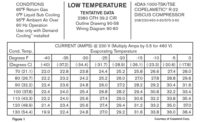Compressor curves are available from compressor manufacturers for each of their models. Compressor data is available in either table (Figure 1) or graph format (Figure 2).
This article will take a closer look at table-type data and concentrate on current (amps) performance data.
The compressor data shown in Figure 1 is for a 10-hp, semi-hermetic, low-temperature Discus® model using R-22 as the refrigerant. The first column of Figure 1 gives the rated conditions and specifications. The rest of the table gives capacity data, power (watts, W), current (amps, A), and evaporator mass flow rate.
PROBLEM AND SOLUTION
Problem:Let us assume this compressor is operating at 230 V, has an evaporator temperature of 0 degrees F, and a condensing temperature of 90 degrees. Determine the correct current (A) draw for this compressor using the table.Solution: The intersection of the 90 degree condensing temperature with a 0 degree evaporating temperature results in an amp draw of 31.6 A. The data tells us that this compressor, operating under these pressures, should draw 31.6 A at 230 V. If the compressor was operating at 460 V, the amp values in the table would have to be multiplied by one-half.
The service technician measures the compressor amps with an ammeter at the compressor. The tech finds that the amps are very close to the 31.6 A the table said they should be at these pressures. So the tech has a pretty good idea that the compressor is operating up to spec.
If, however, the technician measures the current draw of the compressor and finds that it is pulling only 24 A at these same conditions, he knows there is a problem somewhere. Here are some reasons why a compressor would pull low amperage:
The service technician must now systematically check each of these potential causes and find the one that is causing the low amp draw.
Notice that in Figure 1, as the condensing temperature decreases, so do the amps. This is assuming a constant evaporating temperature. Also, as the evaporating temperature decreases, so do the amps. This is assuming a constant condensing pressure.
Decreased condensing temperatures mean lower condensing pressures. The compressor’s piston now operates with less pressure against it as it compresses the suction gases. This, in turn, means less stress on the motor and less amp draw.
As the evaporating temperature decreases, so do the evaporating pressures. These lower pressures entering the compressor cylinders mean less dense vapors are filling the cylinders. Less mass flow rate of refrigerant vapor is pumped by the compressor. This causes the decreased amp draw.
Note: Operating conditions other than evaporating and condensing temperatures (pressures) are used for these tables. The conditions in the middle of the first column of Figure 1 must be met for the values to be 100% accurate. The conditions are:
If these conditions do not exist, the table will not be 100% accurate. However, for the purpose of systematic field troubleshooting, these inaccuracies are not great enough to have any great effect on a good service technician’s judgment.
Tomczyk is a professor of hvac at Ferris State University, Big Rapids, MI, and author of the book Troubleshooting and Servicing Modern Air Conditioning & Refrigeration Systems, published by ESCO Press. To order, call 800-726-9696. Tomczyk can be reached at tomczykj@tucker-usa.com (e-mail).
Publication date: 04/01/2002




